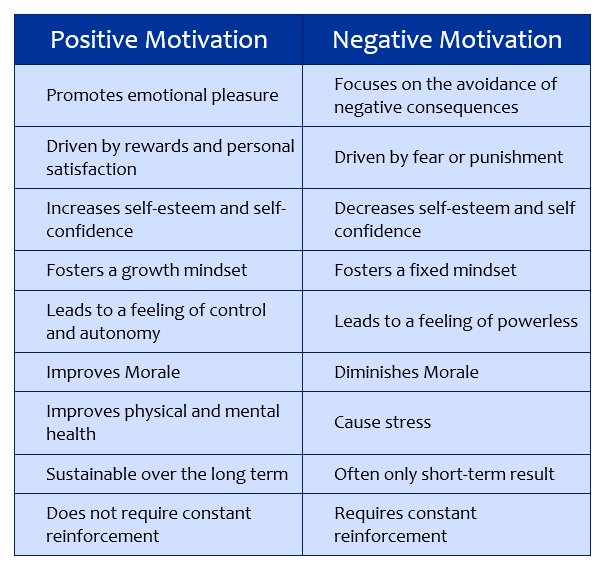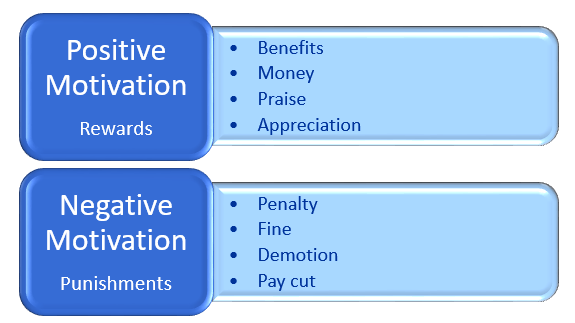Motivation is a drive or desire to behavior in a certain way. While there are many types of motivation, it is generally either positive or negative. Positive motivation is when a person behaves a certain way to get rewarded, and negative motivation is when a person behaves a certain way to avoid something bad.
Positive and Negative Motivation
Positive Motivation is an influence on a person’s behavior through recognition and appreciation of their efforts to inspire them to achieve their goals and reach their full potential.
Negative Motivation is an influence that drives a person to complete a task to avoid undesirable outcomes such as pain or failure.
About Positive Motivation
Positive motivation occurs when a person knows they will be rewarded for accomplishing a certain task or changing a particular behavior. A person becomes motivated when they visualize themselves receiving the reward. With positive motivation, the individual derives enjoyment from completing a task.
Positive Motivation can be used as a reward-based method that creates a desire to perform better and achieve specific goals. This method encourages individuals to perform better by providing them with rewards, recognition, and other incentives that show appreciation for their efforts. The rewards and incentives reinforce the performance and encourages the individual to reproduce the action that generated the good feelings. A person’s desire to seek out pleasure and propel themselves forward towards a goal will increase when there is a reward for it.
There are several benefits to positive motivation including an increase in a person’s confidence, promotion of a growth mindset, and sustainability over a long period of time.
Examples of positive motivation:
- Rewards
- Money
- Benefits
- Praise
- Appreciation
About Negative Motivation
Negative motivation is the act of forcing a specific behavior by means of fear, threat, or punishment. It is based upon fear and punishment. The theory behind it is that a person will take an action to avoid experiencing something bad such as punishment, pain, or failure.
Negative motivation is created when a person has something to lose, and stems from the fear of losing it. However, the problem with this type of motivation is that a person will not act until the pain of not doing something outweighs the pain of doing it.
This type of motivation is often used to discourage people from engaging in negative behaviors or to prevent them from making mistakes. Techniques in negative motivation include punishment, fines, or the threat of losing something valuable.
Examples of negative motivation:
- Demotion
- Losing job
- Fine
- Penalty
- Pay cut
Summary – Differences between Positive and Negative Motivation
Positive motivation promotes emotional pleasure, while negative motivation serves to avoid undesirable consequences.
Negative motivation techniques focus on the consequences of underperforming and failing to meet expectations instead of positive motivation, where the focus is on the benefits of a high-quality performance.
Positive Motivation
- Promotes emotional pleasure
- Driven by rewards and personal satisfaction
- Increases self-esteem and self-confidence
- Fosters a growth mindset
- Leads to a feeling of control and autonomy
- Improves morale
- Improves physical and mental health
- Sustainable over the long term
- Does not require constant reinforcement
Negative Motivation
- Focuses on the avoidance of negative consequences
- Driven by fear or punishment
- Decreases self-esteem and self confidence
- Fosters a fixed mindset
- Leads to a feeling of powerless
- Diminishes morale
- Cause stress and burnout
- Often only short-term results
- Requires constant reinforcement
Positive and Negative Motivation Chart



